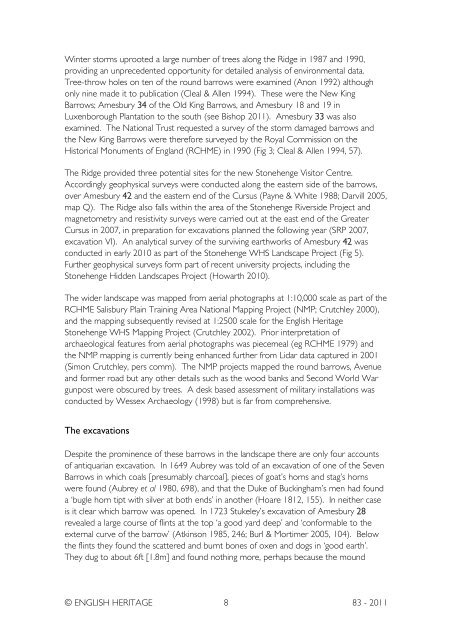King Barrow Ridge - English Heritage
King Barrow Ridge - English Heritage
King Barrow Ridge - English Heritage
Create successful ePaper yourself
Turn your PDF publications into a flip-book with our unique Google optimized e-Paper software.
Winter storms uprooted a large number of trees along the <strong>Ridge</strong> in 1987 and 1990,providing an unprecedented opportunity for detailed analysis of environmental data.Tree-throw holes on ten of the round barrows were examined (Anon 1992) althoughonly nine made it to publication (Cleal & Allen 1994). These were the New <strong>King</strong><strong>Barrow</strong>s; Amesbury 34 of the Old <strong>King</strong> <strong>Barrow</strong>s, and Amesbury 18 and 19 inLuxenborough Plantation to the south (see Bishop 2011). Amesbury 33 was alsoexamined. The National Trust requested a survey of the storm damaged barrows andthe New <strong>King</strong> <strong>Barrow</strong>s were therefore surveyed by the Royal Commission on theHistorical Monuments of England (RCHME) in 1990 (Fig 3; Cleal & Allen 1994, 57).The <strong>Ridge</strong> provided three potential sites for the new Stonehenge Visitor Centre.Accordingly geophysical surveys were conducted along the eastern side of the barrows,over Amesbury 42 and the eastern end of the Cursus (Payne & White 1988; Darvill 2005,map Q). The <strong>Ridge</strong> also falls within the area of the Stonehenge Riverside Project andmagnetometry and resistivity surveys were carried out at the east end of the GreaterCursus in 2007, in preparation for excavations planned the following year (SRP 2007,excavation VI). An analytical survey of the surviving earthworks of Amesbury 42 wasconducted in early 2010 as part of the Stonehenge WHS Landscape Project (Fig 5).Further geophysical surveys form part of recent university projects, including theStonehenge Hidden Landscapes Project (Howarth 2010).The wider landscape was mapped from aerial photographs at 1:10,000 scale as part of theRCHME Salisbury Plain Training Area National Mapping Project (NMP; Crutchley 2000),and the mapping subsequently revised at 1:2500 scale for the <strong>English</strong> <strong>Heritage</strong>Stonehenge WHS Mapping Project (Crutchley 2002). Prior interpretation ofarchaeological features from aerial photographs was piecemeal (eg RCHME 1979) andthe NMP mapping is currently being enhanced further from Lidar data captured in 2001(Simon Crutchley, pers comm). The NMP projects mapped the round barrows, Avenueand former road but any other details such as the wood banks and Second World Wargunpost were obscured by trees. A desk based assessment of military installations wasconducted by Wessex Archaeology (1998) but is far from comprehensive.The excavationsDespite the prominence of these barrows in the landscape there are only four accountsof antiquarian excavation. In 1649 Aubrey was told of an excavation of one of the Seven<strong>Barrow</strong>s in which coals [presumably charcoal], pieces of goat’s horns and stag’s hornswere found (Aubrey et al 1980, 698), and that the Duke of Buckingham’s men had founda ‘bugle horn tipt with silver at both ends’ in another (Hoare 1812, 155). In neither caseis it clear which barrow was opened. In 1723 Stukeley’s excavation of Amesbury 28revealed a large course of flints at the top ‘a good yard deep’ and ‘conformable to theexternal curve of the barrow’ (Atkinson 1985, 246; Burl & Mortimer 2005, 104). Belowthe flints they found the scattered and burnt bones of oxen and dogs in ‘good earth’.They dug to about 6ft [1.8m] and found nothing more, perhaps because the mound© ENGLISH HERITAGE 8 83 - 2011
















